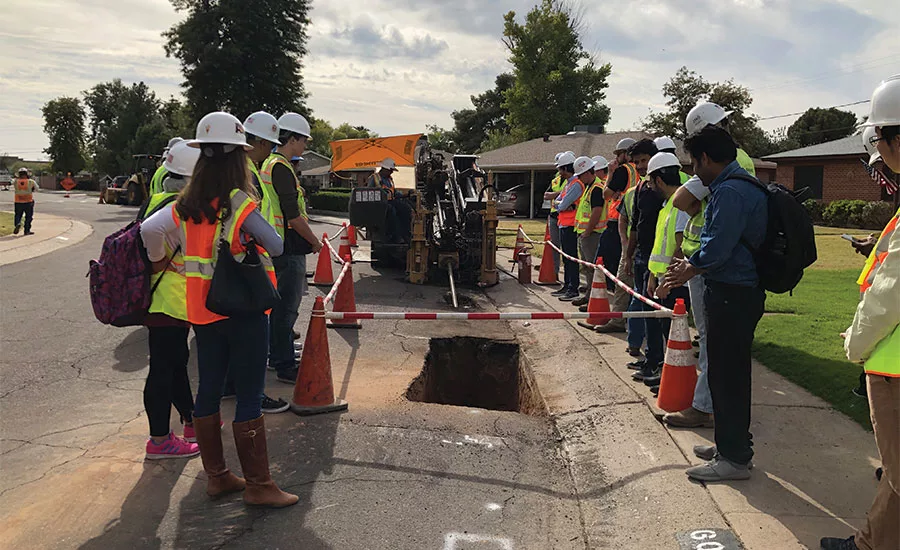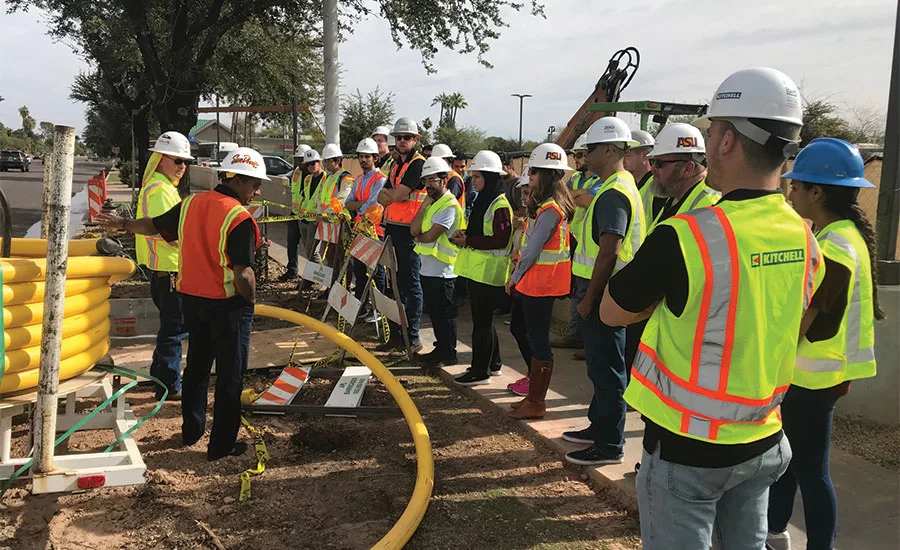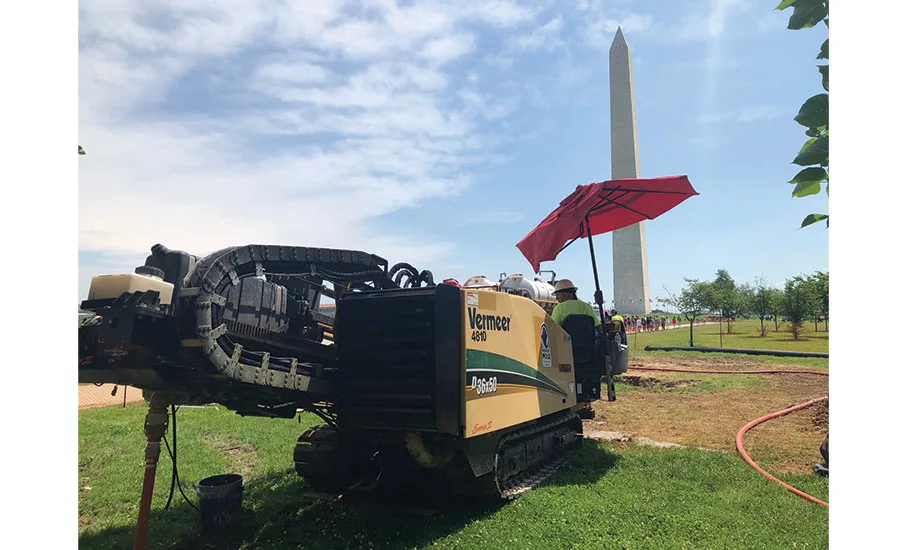How Associations Advance the Drilling Industry

Arizona State University students learning about HDD.
Source: Samuel T. Ariaratnam photos


It’s important for associations to serve as a link between their members and government agencies, contractors, business owners and other industry organizations. That link can be facilitated by programs, committees, organized events and educational sessions. The National Drilling Association, the International Association of Drilling Contractors, and the American Association of Drilling Engineers are just a few examples of groups that create and maintain that connection.
Another one is the Distribution Contractors Association. The non-profit trade organization, formed in 1961, boasts a reputation as “a tight-knit family.” Open to all companies in gas distribution and mainline construction, the association also focuses and engages in horizontal directional drilling (HDD), as well as water and pipeline rehabilitation work.
That focus on HDD led to the forming of a committee that’s in charge of supporting the safety, training, technical developments, and voluntary operational guidelines that sustain professional practices and contractors in the HDD industry. Their mission? “To promote the use and education of horizontal directional drilling as a viable, safe and environmentally friendly construction method.”
At the recent Underground Construction Technology (UCT) event in Fort Worth, Texas, a panel of representatives from the DCA presented on inadvertent return management and strategies, and discussed the DCA’s efforts to support and facilitate best practices throughout the HDD industry. Samuel T. Ariaratnam, Ph.D., PE, P.Eng., F.ASCE, FCAE, and professor and construction engineering program chair at Arizona State University, was one of the panel members.
Ariaratnam has over 20 years of experience in trenchless engineering research and education. He received his bachelor’s in civil engineering from the University of Waterloo, and his master’s and Ph.D. from the University of Illinois at Urbana-Champaign.
Over time, and throughout the course of his extensive professional career, Ariaratnam focused his research in underground infrastructure management and rehabilitation. More specifically, the development of new technologies in construction engineering and applications of underground trenchless construction techniques, specifically HDD and trenchless pipe replacement.
We spoke with Ariaratnam about the DCA and its mission, the importance of educational initiatives, and the future of the industry.
Our conversation has been edited for space and clarity.
Q. Tell me about the DCA. How does it aim to help contractors/drillers?
A. The Distribution Contractors Association (DCA) was formed in 1961 to facilitate the exchange of information related to the construction and maintenance of gas distribution pipeline systems throughout the United States. Today, the membership has evolved to also include turnkey utility contractors that operate at all levels of utility construction and directional drilling.
As an association, the DCA provides a forum for its members to engage in discussions about various aspects of the utility industry. Furthermore, the various committees including the HDD Committee enable stakeholders to share their experiences and provide a unified voice to government agencies regarding concerns.
Q. What has the DCA been working on lately?
A. There are many different areas that the DCA has been working on lately. Workforce development is one area that is a reality for the construction industry as a whole. With an aging workforce, there is a dire need to fill these [voids left by] retiring workers with a new generation to create a sustainable future workforce.
Another area is addressing concerns about inadvertent returns (IRs) during HDD operations. All stakeholders in the HDD industry have collectively worked together in providing information via documents and presentations to various government agencies to provide a better understanding of IRs.
This past June, the DCA organized a jobsite field trip in Washington, D.C., and invited various stakeholders. Congressional staffers, labor organizations, environmental groups and other trade associations attended the field trip to see firsthand an HDD installation of new water lines on the Washington Mall. The experience provided an excellent opportunity for questions and answers on various aspects of HDD.
Q. Can you tell me more about this Washington, D.C., field trip? Why was it important? What does it mean for drillers?
A. The Washington, D.C., field trip was an opportunity for key government stakeholders to better understand the HDD process. I think it was important for people to visually see how little surface disruption there was on the highly traveled Washington Mall compared to a traditional open cut alternative. The promotion of HDD and other trenchless methods requires repeated outreach to better educate the public on the benefits. And better informed decision-making should result in more HDD projects.
Q. You mentioned IRs. What can you tell me about them? How can drillers manage these occurrences best? What are some strategies for them to focus on?
A. IRs occur when drilling fluids escape the borehole during an HDD installation. Sometimes, these are a result of over-pressurizing the borehole, while other times these are a result of natural channels such as fractures and fissures in the ground that are not directly related to the drilling process. IRs tend to travel through the path of least resistance, which is normally upward toward the surface. Prudent contractors must have an IR contingency plan [in place] with a containment strategy, and often include pressure monitoring equipment during the drilling process to continually monitor downhole pressures.
Q. At the 2019 UCT show in Texas, you mentioned educational initiatives being an important factor. Can you explain these to me? What is their aim?
A. The DCA has a broad membership of stakeholders in the utility industry. Consequently, the association is well-positioned to provide excellent programs to better educate the public. For example, educational sessions are organized and delivered by DCA members at the UCT show and the International Construction Utility Equipment Expo (ICUEE) on timely topics.
Many DCA members also present papers at the annual No-Dig Show organized by the North American Society for Trenchless Technology (NASTT) and the ASCE Pipelines Conference held by the American Society of Civil Engineers (ASCE). The DCA is a supporting organization of the Horizontal Directional Drilling Academy held each February in Tempe, Arizona. That HDD Academy provides a comprehensive two-day educational program that is taught by industry stakeholders, most of whom are DCA members.
Q. You mentioned engagement at universities as being a crucial aspect of education. Tell me about that. How does engagement at universities benefit the drilling industry?
A. DCA members regularly lecture in engineering, construction and drilling classes at universities across the country. The sharing of contractor “real-world” experiences is extremely beneficial to the next generation of engineers and drillers. Also, DCA members provide their projects for student field trips to show actual utility construction activities. And many of the members hire student summer interns, who are often hired upon graduation.
Q. What is the future of the industry? What would you like to see the future of the industry be?
A. With an aging infrastructure in various stages of deterioration here in the United States, I see a very bright future in the utility construction sector. Today, trenchless technologies such as horizontal directional drilling, pipe bursting, micro-tunneling, and pipe re-lining (to name a few) are being used daily in rehabilitating and replacing our aging underground utilities. Furthermore, population growth worldwide has necessitated the need for the installation of more buried infrastructure to meet societal demands. It is an excellent time to be involved in the drilling industry!
Looking for a reprint of this article?
From high-res PDFs to custom plaques, order your copy today!





